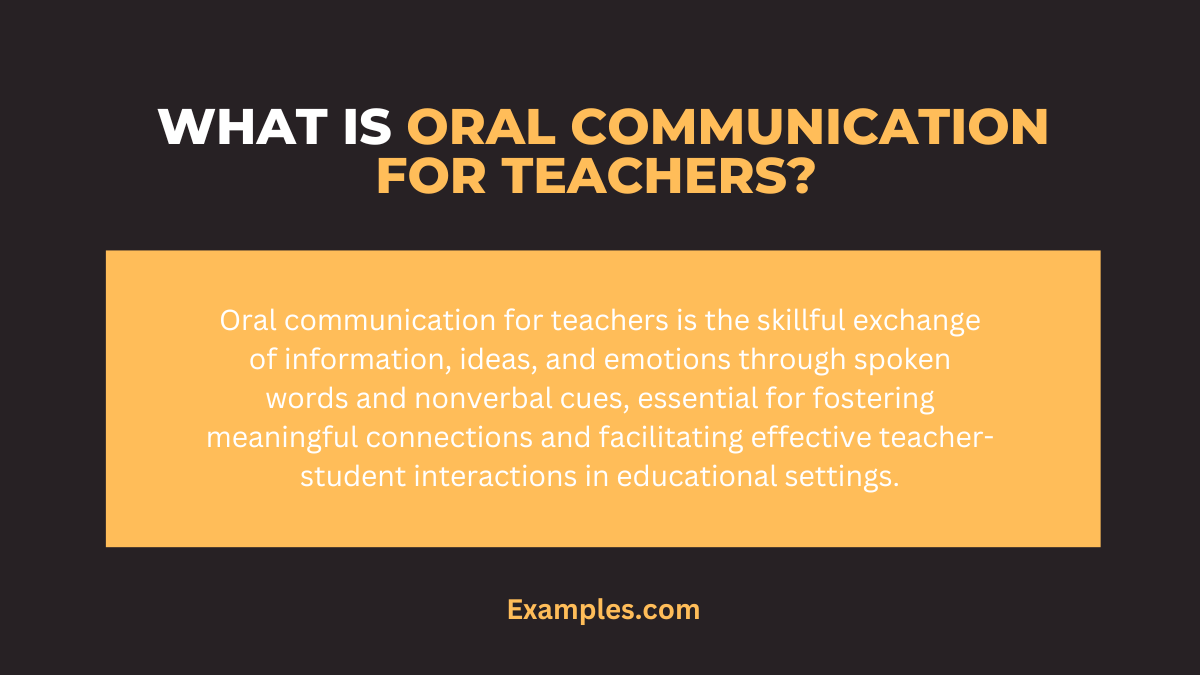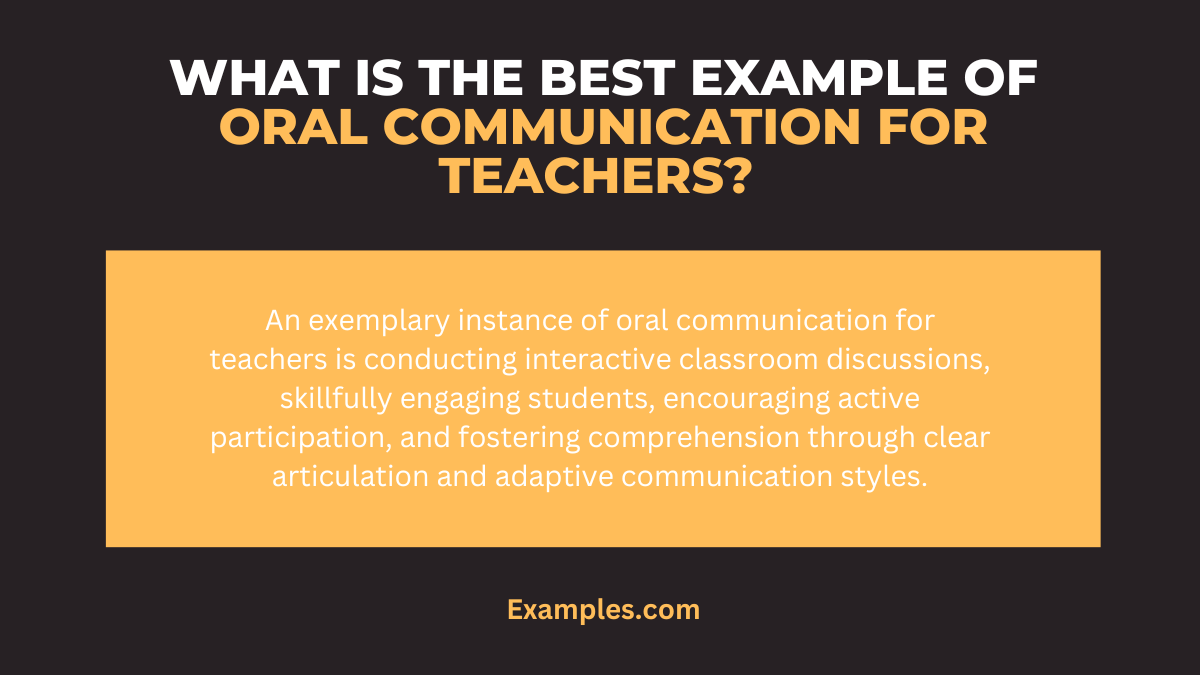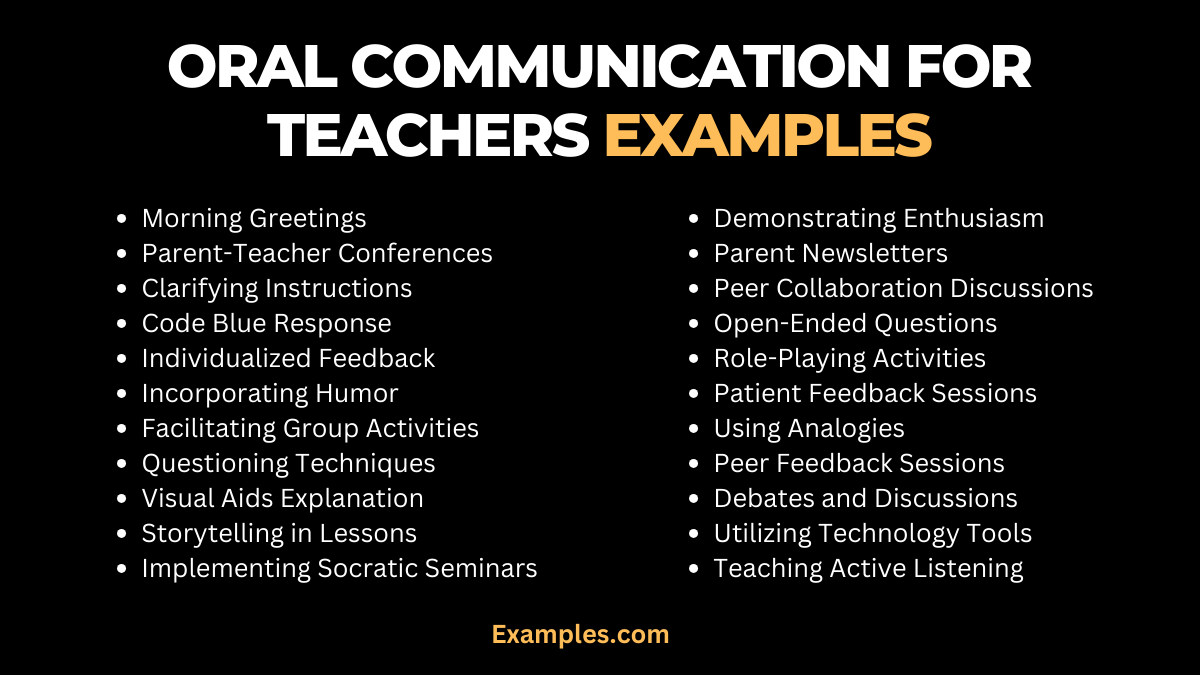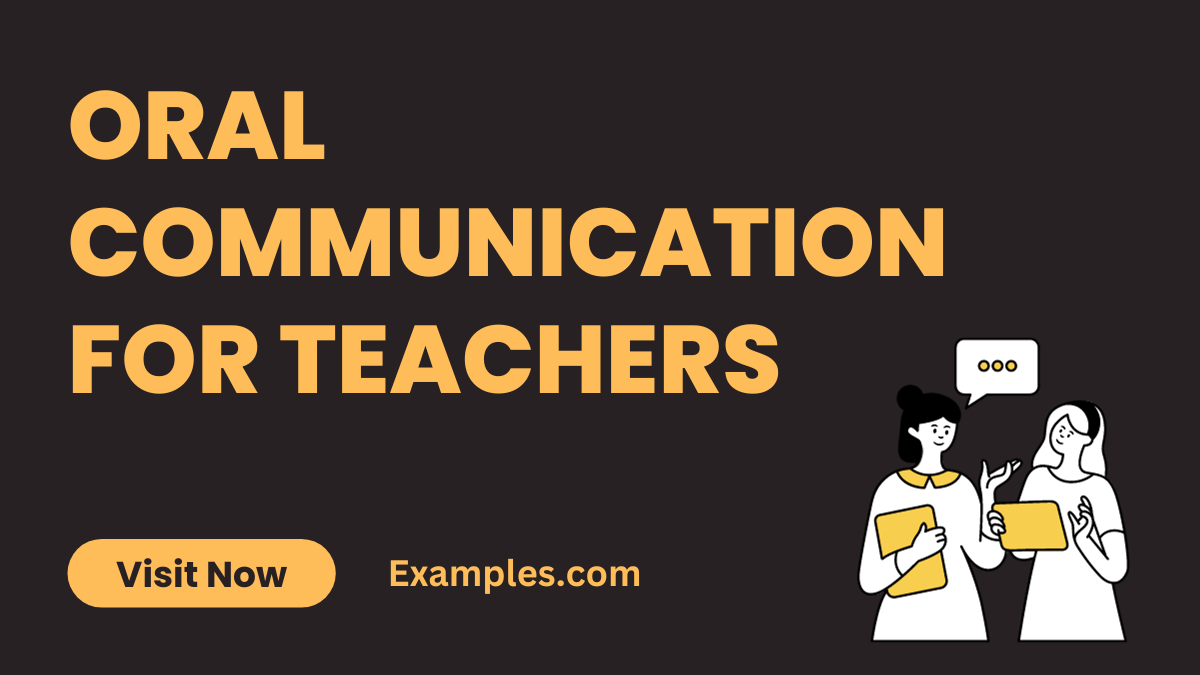29+ Oral Communication for Teachers Examples
Embark on a comprehensive journey through the domain of Oral Communication for Teachers in our complete guide, enriched with impactful Communication Examples. This resource illuminates the importance of effective communication skills in the classroom, literature studies, and school settings. Learn essential tips to navigate diverse communication scenarios, fostering an environment conducive to robust teacher-student interactions and successful education outcomes. Elevate your teaching experience with insights that encompass the nuances of verbal and nonverbal communication in educational settings.
What is Oral Communication for Teachers?

Oral communication for teachers refers to the exchange of information, ideas, and emotions through spoken words and nonverbal cues in educational settings. This dynamic process is crucial for effective teacher-student interactions, classroom management, and conveying instructional content in a clear and engaging manner. In essence, it involves the skillful use of verbal and nonverbal communication techniques to facilitate meaningful connections and foster a conducive learning environment.
What is the Best Example of Oral Communication for Teachers?

An exemplary instance of oral communication for teachers is the art of conducting interactive classroom discussions. This involves the teacher skillfully engaging students in conversation, encouraging active participation, and eliciting thoughtful responses. By employing clear articulation, active listening, and adapting communication styles to suit diverse student needs, teachers can create an environment where ideas flow seamlessly, fostering both comprehension and student engagement. This example showcases how effective oral communication is pivotal for impactful teaching and learning experiences.
30 Oral Communication for Teachers Examples

Explore a myriad of Oral Communication for Teachers examples, each illuminating the diverse ways educators can enhance teaching through effective communication. Our SEO-friendly insights offer practical scenarios, guiding teachers to refine their communication skills for a vibrant and engaging classroom experience.
- Morning Greetings:
- Start the day with warm greetings, fostering a positive and inclusive classroom atmosphere for effective communication.
- Parent-Teacher Conferences:
- Navigate these conferences with clarity and empathy, ensuring productive discussions on student progress and improvement strategies.
- Interactive Read-Aloud Sessions:
- Engage students in discussions during read-aloud sessions, promoting active listening and comprehension through verbal exchanges.
- Clarifying Instructions:
- Use precise language to clarify instructions, reducing confusion and promoting better understanding among students.
- Individualized Feedback:
- Provide personalized feedback, emphasizing specific strengths and areas for improvement in student work.
- Incorporating Humor:
- Infuse humor into lessons, creating a relaxed and enjoyable environment that enhances communication and student engagement.
- Facilitating Group Activities:
- Guide group activities with effective communication, ensuring all students contribute and comprehend the assigned tasks.
- Questioning Techniques:
- Employ diverse questioning techniques to stimulate critical thinking and encourage thoughtful responses from students.
- Visual Aids Explanation:
- Clarify concepts with visual aids, enhancing communication by providing additional context for better understanding.
- Storytelling in Lessons:
- Incorporate storytelling to make lessons more engaging, fostering a connection between the teacher, content, and students.
- Digital Communication Etiquette:
- Teach students appropriate digital communication, emphasizing the importance of clarity and professionalism.
- Demonstrating Enthusiasm:
- Convey passion and enthusiasm for the subject, inspiring students and creating a positive learning atmosphere.
- Parent Newsletters:
- Craft newsletters that effectively communicate important information, updates, and insights for parents.
- Using Body Language:
- Leverage positive body language to convey confidence, approachability, and engagement during lessons.
- Peer Collaboration Discussions:
- Encourage effective communication in peer collaboration, fostering teamwork and collective understanding.
- Open-Ended Questions:
- Pose open-ended questions to stimulate class discussions, promoting critical thinking and diverse perspectives.
- Providing Clear Expectations:
- Clearly communicate expectations for assignments, assessments, and classroom behavior to guide student actions.
- Role-Playing Activities:
- Engage students in role-playing activities to enhance communication skills, empathy, and understanding of various perspectives.
- Encouraging Student Reflections:
- Foster communication by encouraging students to reflect on their learning experiences and share insights with the class.
- Using Analogies:
- Clarify complex concepts with relatable analogies, making lessons more accessible and facilitating student understanding.
- Peer Feedback Sessions:
- Structure peer feedback sessions to promote constructive communication, helping students refine their work through collaborative input.
- Addressing Misconceptions:
- Actively address student misconceptions with clarity, ensuring a thorough understanding of the subject matter.
- Debates and Discussions:
- Organize debates and discussions to enhance communication, critical thinking, and articulation skills among students.
- Utilizing Technology Tools:
- Incorporate technology tools for effective communication, enhancing engagement and accessibility in the learning process.
- Teaching Active Listening:
- Dedicate time to teach and reinforce active listening skills, fostering a classroom culture that values attentive understanding.
- Parent-Teacher Communication Platforms:
- Utilize communication platforms for transparent and consistent updates on student progress, events, and classroom activities.
- Implementing Socratic Seminars:
- Facilitate Socratic seminars for in-depth discussions, promoting dialogue and critical analysis among students.
- Visual Schedule Explanation:
- Use visual schedules to communicate daily routines, fostering predictability and a sense of security among students.
- Effective Use of Pauses:
- Master the art of strategic pauses to emphasize key points, allowing students time to process information and contribute to discussions.
- Student-Led Conferences:
- Empower students in their learning journey by facilitating student-led conferences, promoting self-expression and accountability.
Oral Communication for Teachers in School Examples
Discover impactful Oral Communication for Teachers in School examples that transcend traditional teaching boundaries. Our SEO-friendly insights delve into scenarios within school settings, equipping educators with effective communication strategies to engage students, facilitate learning, and foster a positive and inclusive classroom environment.
- Morning Assembly Announcements:
- Address the entire school with clarity during morning assemblies, ensuring important announcements reach all students and staff.
- Parent-Teacher Association Meetings:
- Communicate effectively with parents during PTA meetings, fostering collaboration and discussing students’ progress and school initiatives.
- Teacher-Staff Collaborative Planning:
- Facilitate communication among teachers and staff during collaborative planning sessions, ensuring a cohesive approach to curriculum and school activities.
- Emergency Evacuation Procedures:
- Clearly articulate emergency procedures to students and staff, ensuring everyone understands and follows safety protocols during drills or actual events.
- Counseling and Guidance Sessions:
- Communicate empathetically during counseling sessions, creating a safe space for students to express concerns, seek guidance, and receive support.
- Interactive Classroom Technology Use:
- Effectively communicate the use of interactive technology in the classroom, enhancing student engagement and understanding of digital resources.
- Teacher-Principal Meetings:
- Engage in effective communication during meetings with the principal, discussing school matters, initiatives, and addressing teacher concerns.
- Extracurricular Activity Coordination:
- Coordinate extracurricular activities with clarity, ensuring effective communication among teachers, students, and parents involved.
- Parent-Teacher Communication Platforms:
- Utilize digital platforms to communicate school updates, events, and student progress, promoting transparent and consistent information flow.
- Student Awards and Recognition:
- Announce student achievements and awards with enthusiasm during school ceremonies, fostering a positive culture of recognition and motivation.
Oral Communication for Teacher in Literature Examples
Delve into effective Oral Communication for Teachers in Literature with our enriching examples. Elevate your literary discussions, engage students in meaningful conversations, and foster a deeper understanding of texts. Explore the nuances of communication in literature classes, promoting a vibrant exchange of ideas and insights.
- Analyzing Symbolism:
- Engage students by orally communicating the symbolic significance of literary elements, encouraging them to explore hidden meanings.
- Exploring Character Motivations:
- Initiate classroom discussions by delving into character motivations, prompting students to express their interpretations and insights.
- Facilitating Book Clubs:
- Guide oral discussions in book clubs, encouraging students to share opinions, critique, and discuss various aspects of the assigned literature.
- Interpreting Poetry Aloud:
- Enhance communication by having students read and interpret poetry aloud, fostering an appreciation for rhythm, tone, and metaphor.
- Role-Playing Literary Scenes:
- Promote interactive learning by having students role-play scenes from literature, encouraging creativity and understanding of character dynamics.
- Comparative Analysis Discussions:
- Facilitate discussions comparing different literary works, prompting students to articulate similarities, differences, and thematic connections.
- Narrative Structure Exploration:
- Discuss the narrative structure of literary works, guiding students to analyze how plot elements contribute to the overall storytelling.
- Explaining Cultural Context:
- Enhance oral communication by discussing the cultural context of literature, fostering a deeper understanding of historical and societal influences.
- Character Dialogue Analysis:
- Engage students in dissecting character dialogues, encouraging them to explore speech patterns, subtext, and character relationships.
- Oral Storytelling Sessions:
- Encourage students to orally share personal interpretations of stories, promoting individual expression and diverse perspectives.
Oral Communication for Teachers in the Classroom Examples
Unlock effective Oral Communication for Teachers in the Classroom with these dynamic examples. From classroom management to instructional delivery, these instances showcase how clear and engaging communication contributes to a positive and impactful learning environment.
- Setting Clear Expectations:
- Verbally communicate classroom expectations at the beginning of the school year, fostering a positive and organized learning environment.
- Encouraging Student Questions:
- Foster open communication by encouraging students to ask questions during lessons, promoting active participation and clarity.
- Providing Timely Feedback:
- Communicate constructive feedback promptly, ensuring students receive guidance and support for continuous improvement.
- Utilizing Visual Aids:
- Enhance communication by using visual aids during lessons, helping students visualize concepts and reinforcing verbal explanations.
- Interactive Whiteboard Explanations:
- Utilize interactive whiteboards for dynamic explanations, enhancing engagement and providing a multi-sensory learning experience.
- Implementing Group Discussions:
- Facilitate group discussions to encourage peer-to-peer communication, collaboration, and a deeper understanding of the lesson.
- Clarifying Assignment Instructions:
- Ensure clarity in oral communication by providing detailed explanations of assignments, reducing confusion and promoting student success.
- Addressing Classroom Concerns:
- Foster a supportive atmosphere by openly addressing and resolving classroom concerns, promoting a positive and safe learning environment.
- Socratic Seminars:
- Implement Socratic seminars to encourage in-depth discussions, critical thinking, and effective communication among students.
- Utilizing Technology for Communication:
- Leverage technology tools to communicate important updates, assignments, and resources, enhancing accessibility and transparency for students.
Why is Oral Communication Important for Teachers?
Oral communication stands as a cornerstone skill for teachers, wielding profound significance in various dimensions of education. In the realm of teaching, effective verbal communication serves as a linchpin for successful interactions, learning experiences, and the overall development of students.
1. Facilitating Clear Instruction: Oral communication allows teachers to convey complex concepts with clarity. It is through spoken words that teachers articulate instructions, explain theories, and provide explanations, ensuring students comprehend the subject matter.
2. Fostering Student Engagement: Engaging students is a key facet of effective teaching. Oral communication, when infused with enthusiasm, energy, and dynamic delivery, captivates students’ attention, making the learning process more compelling and enjoyable.
3. Building Positive Teacher-Student Relationships: The quality of oral communication directly influences the teacher-student relationship. By being approachable, using empathetic communication, and actively listening, teachers create an environment where students feel comfortable expressing themselves.
4. Encouraging Critical Thinking: Oral communication serves as a vehicle for stimulating critical thinking. Through class discussions, questioning techniques, and encouraging students to articulate their thoughts, teachers promote analytical skills and deeper understanding.
5. Providing Constructive Feedback: Effective oral communication enables teachers to provide constructive feedback. Whether praising achievements or addressing areas for improvement, clear and supportive communication fosters a growth mindset among students.
What Teachers Need to Know About Oral Language?
Oral language plays a foundational role in education, and for teachers, understanding its nuances is instrumental in fostering effective communication, learning, and overall student development. Delving into the intricacies of oral language equips educators with valuable insights to create a vibrant and inclusive learning environment.
1. Importance of Early Language Development:
- Teachers should grasp the significance of early language development in children. Understanding the stages of language acquisition and milestones helps identify and address potential challenges, ensuring a solid foundation for future academic success.
2. Language as a Social Construct:
- Oral language is inherently social, influencing how students interact and connect with others. Teachers need to recognize the social dimension of language, emphasizing activities that promote collaborative communication, peer interactions, and a positive classroom culture.
3. Diverse Language Backgrounds:
- Teachers operate in increasingly diverse classrooms. Recognizing and appreciating the linguistic diversity among students is crucial. Strategies for supporting English language learners and maintaining an inclusive environment empower teachers to address the needs of all learners effectively.
4. Vocabulary Development Strategies:
- Teachers play a pivotal role in expanding students’ vocabulary. Employing diverse strategies such as read-aloud sessions, word games, and contextual learning helps enhance students’ word knowledge, comprehension, and overall language proficiency.
5. Impact of Teacher Language:
- Teachers’ language choices significantly influence the classroom atmosphere. Being mindful of language use, including tone, clarity, and positivity, contributes to a supportive learning environment, fostering student engagement and motivation.
Tips for Effective Oral Communication for Teachers?
Oral communication is a fundamental skill for teachers, impacting their ability to convey information, engage students, and foster a positive learning environment. Mastering effective oral communication is crucial for educators to impart knowledge, build relationships, and create a dynamic classroom experience. Here are actionable tips to enhance oral communication for teachers:
1. Clarity and Conciseness: Ensure clarity in speech, avoiding unnecessary jargon. Be concise in conveying information, allowing students to grasp key concepts without confusion.
2. Active Listening: Cultivate active listening skills to understand student questions, concerns, and responses. This fosters a responsive and supportive teacher-student dynamic.
3. Modulation and Tone: Vary your voice modulation and tone to emphasize key points, maintain engagement, and convey enthusiasm about the subject matter.
4. Nonverbal Communication: Leverage nonverbal cues such as gestures, facial expressions, and body language to complement verbal communication, enhancing overall message delivery.
5. Encourage Student Participation: Create a participative environment by encouraging students to ask questions, share thoughts, and engage in class discussions, promoting a two-way communication flow.
In conclusion, the art of oral communication for teachers is a multifaceted skill that significantly shapes the educational experience. It’s not just about conveying information; it’s about creating an atmosphere where students feel valued, understood, and motivated. Effective oral communication involves a harmonious blend of clarity, empathy, and adaptability, allowing educators to meet the diverse needs of their students. Teachers who excel in this area are able to foster a more dynamic, inclusive, and engaging learning environment, ultimately contributing to the overall success and well-being of their students.
Moreover, the continuous evolution of teaching methodologies underscores the importance of staying informed about the latest educational trends and practices. For further insights into effective teaching strategies, educators can refer to Harvard’s Project Zero, a renowned educational research group that offers a wealth of resources on innovative teaching methods. Additionally, the U.S. Department of Education provides a plethora of guidelines and updates on educational policies and best practices, serving as a valuable tool for teachers seeking to enhance their professional skills and knowledge.
These resources complement the practical scenarios discussed earlier, offering teachers a comprehensive guide to refining their oral communication skills for a vibrant and engaging classroom experience.



